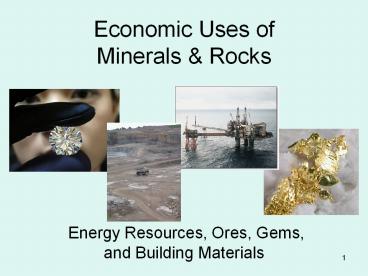Economic Uses of Minerals & Rocks - PowerPoint PPT Presentation
1 / 14
Title:
Economic Uses of Minerals & Rocks
Description:
Economic Uses of Minerals & Rocks Energy Resources, Ores, Gems, and Building Materials * * Our Earth Resources Why you must have someone somewhere who develops the ... – PowerPoint PPT presentation
Number of Views:352
Avg rating:3.0/5.0
Title: Economic Uses of Minerals & Rocks
1
Economic Uses of Minerals Rocks
- Energy Resources, Ores, Gems, and Building
Materials
2
Our Earth Resources
- Why you must have someone somewhere who develops
the resources you use every day
3
Our Earth Resources
- Resource
- Physical or virtual entity with utility, value,
and limited availability - Ore
- Materials that exist in quantities that can be
extracted and marketed for a profit - Major types of ores
- Metallic (ore mineral)
- Nonmetallic (gem, IM)
- Energy
- Water
4
Energy Resources Coal, Petroleum, and Natural
Gas
- Fossil fuel energy resources are the foundation
of technology-based human societies
US Primary Energy Supply 2009 (US EIA)
5
Oil and Natural Gas Deposits
- Origin
- Organic materials trapped in ocean-bottom
sediments - Decompose within the rocks and form hydrocarbon
liquids (oil and gas) - Hydrocarbons migrate along and within permeable
rock layers - Accumulate in an area that is impermeable - "traps
6
Oil and Natural Gas Deposits in MI
- Reservoir rocks are porous and permeable
- Sandstone, limestone
- Unconventional reservoirs fractured shales
7
Basic Concepts Ore Minerals
- Resource
- Absolute volume of a mineral commodity in
existence, independent of economics and
technology - Reserves or proven reserves
- Known quantity of a resource available (produced
at a profit) - Dependant on current economic conditions
(including demand) and extant technology - Concentration factor
- Ratio of ore material concentration to average
crustal concentration - Mode of occurrence
- A desirable commodity must occur in a mineral
form that is readily processed to produce the
commodity - Associated, unwanted mineral material (gangue)
and waste after processing (tailings) must be
considered in economic assessment
8
Basic Concepts Ore Minerals
- Ore deposits require
- Source for metals (or other elements)
- Means of concentrating elements into usable
quantities - Types of Ore Deposits
- Magmatic (cumulate, lode, pegmatite)
- Hydrothermal (porphyry, vein, skarn, exhalative,
epigenetic) - Sedimentary (placer, BIF, laterite, evaporite)
- Ore Minerals
- Native elements (Au, Ag, Cu, Pt, diamond, sulfur)
- Sulfides and sulfosalts (pyrite, sphalerite,
chalcopyrite, galena) - Oxides and hydroxides (magnetite, chromite,
corundum, hematite, rutile)
9
Magmatic Ore Deposits
- Directly crystallize from magma intrusive or
extrusive - Occur as
- Accessory minerals
- Disseminated deposits
- Lode deposits
- Ore in many small veins
- California gold deposits
- Pegmatite
- Felsic plutons late stage crystallization of
magma - Rich in incompatible elements Li, Cs, Be, Sn, U
- Cumulates
- Dense minerals settle out in ultramafic magma
chamber - Chromite, magnetite, platinum group elements
10
Hydrothermal Ore Deposits
- Involve fluids
- Released from crystallizing magma (felsic
plutons) - Occur as
- Widely disseminated vein networks
- Porphyry
- Alteration of country rock by late, hydrothermal
fluids - Cu, Mo deposited as sulfide minerals in veins
- Skarn
- Fluid alteration of carbonate country rock during
contact metamorphism (metasomatism) - Fe, Pb, Cu, Mo as sulfide or oxide minerals
- Epigenetic
- Ore bodies not physically associated with the
magmatic body that produced the hydrothermal
fluids - Pb-Zn and Au-Sb deposits Upper Mississippi
Valley lead zinc district
11
Sedimentary Ore Deposits
- Concentration of ore minerals due to
- Weathering (laterite, supergene)
- Sorting due to gravity (placer)
- Chemical precipitation (BIF, evaporite)
- Laterite
- Tropical weathering to a residuum of Fe2O3
Al2O3 - Preserved in the geological record as bauxite
- Placers
- Dense, heavy minerals become concentrated in
stream bottoms - California gold deposits
- Banded Iron formation
- Formed in a O2 poor, early earth atmosphere, gt2
billion years old - Fe as hematite
12
Mineral Resources
- In 2000, the estimated value of non-fuel mineral
production for Michigan was 1.67 billion - The state rose to sixth in rank among the 50
states in total non-fuel mineral production value - Michigan accounted for more than 4 of the U.S.
total
13
Mineral Resources of Michigan
- Portland cement
- Cement binding agent in concrete
- Made from limestone, clay minerals and gypsum
- Michigans leading non-fuel mineral commodity
- Construction sand and gravel
- Crushed stone
- Magnesium compounds
- Salt
- Limestone
14
Mineral Resources of Michigan
- Iron ore
- Largely extracted from BIF
- Michigan was the nations second leading iron
ore-producing state in 2000 - Copper
- Native Cu of hydrothermal origin
- Hosted in Precambrian basalt lava flows
- Last mine, the White Pine Mine, closed in 1997

